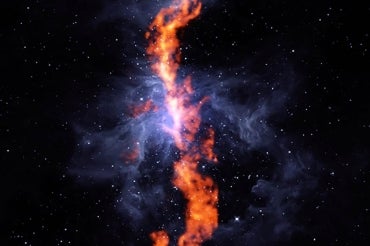Peering deep into the stellar nursery of the Orion Nebula: U of T astronomers part of team

Published: June 15, 2017
Astronomers have released an image of a vast filament of star-forming gas, 1,200 light-years away, in the stellar nursery of the Orion Nebula.
The image shows ammonia molecules within a 50-light-year long filament detected through radio observations made with the Robert C. Byrd Green Bank Telescope in West Virginia. It accompanies the first release of results from a research collaboration published in the Astrophysical Journal Supplement.
A team of researchers are collaborating on a survey of all the major, nearby star-forming regions in the northern half of the Gould Belt – a ring of young stars and gas clouds that circles the entire sky and runs through the constellation Orion. The researchers hope the survey will eventually provide a clearer picture over a larger portion of the sky of the temperatures and motions of gas within these dynamic stellar nurseries.
“We still don’t understand in detail how large clouds of gas in our galaxy collapse to form new stars,” says Rachel Friesen, one of the collaboration’s co-principal researchers who until recently was a fellow at U of T's Dunlap Institute for Astronomy & Astrophysics.
“But ammonia is an excellent tracer of dense, star-forming gas, and these large ammonia maps will allow us to track the motions and temperature of the densest gas. This is critical to assessing whether gas clouds and filaments are stable, or are undergoing collapse on their way to forming new stars.”
The image is combined with an image of the Orion Nebula – an object familiar to amateur and professional astronomers alike – taken with NASA’s wide-field infrared survey explore (WISE) telescope.
The collaboration’s other co-principal investigator is Jaime Pineda, from the Max Planck Institute for Extraterrestrial Physics. The team also includes Associate Professor Chris Matzner and graduate student Ayushi Singh from the University of Toronto’s department of astronomy & astrophysics, and the Canadian Institute for Theoretical Astrophysics Professor Peter Martin, who helped found the Dunlap Institute.



